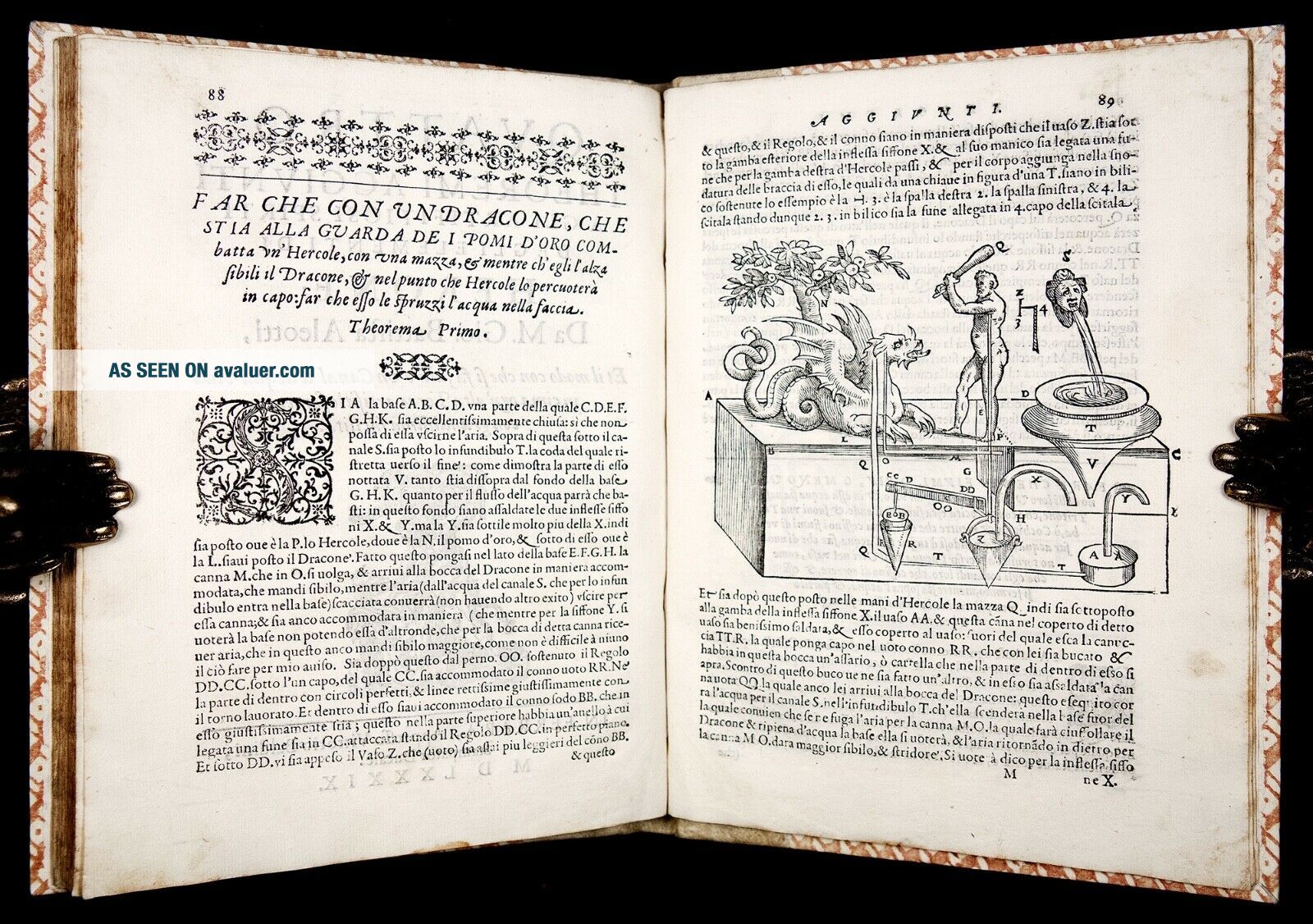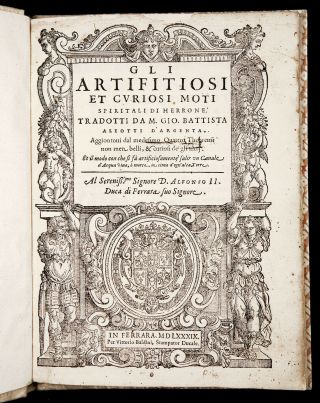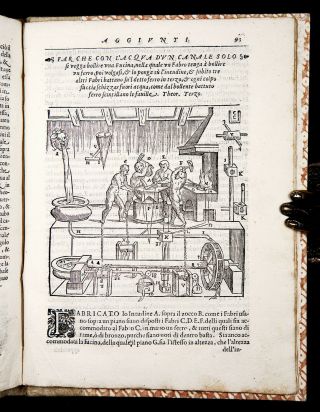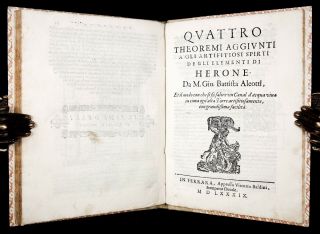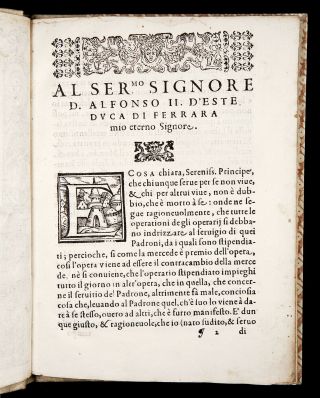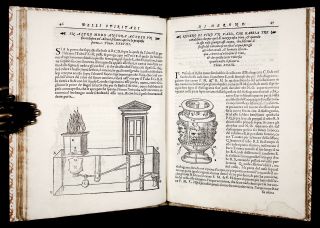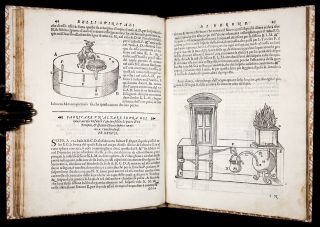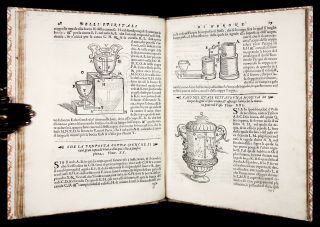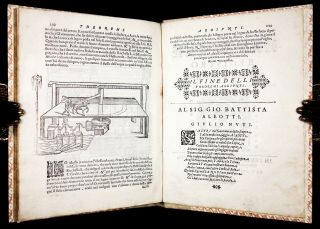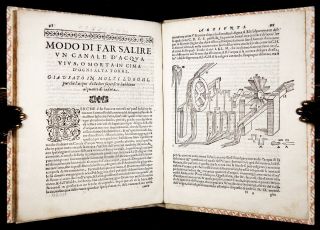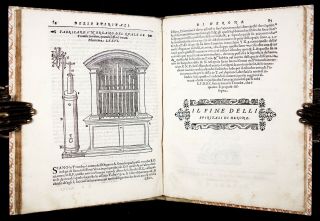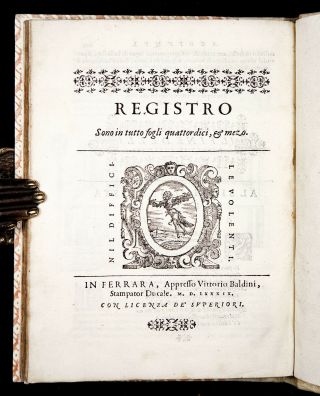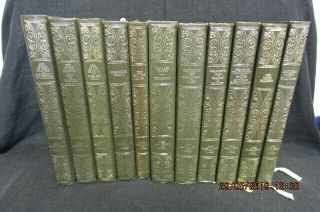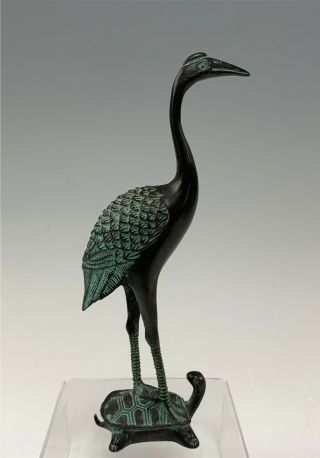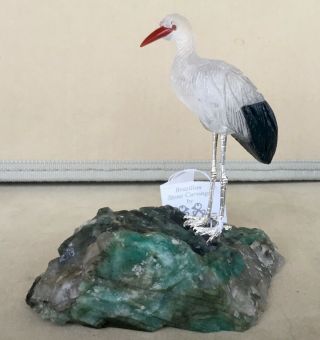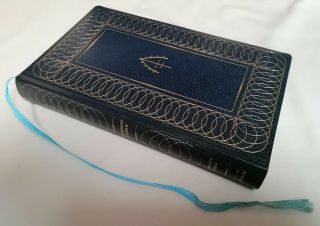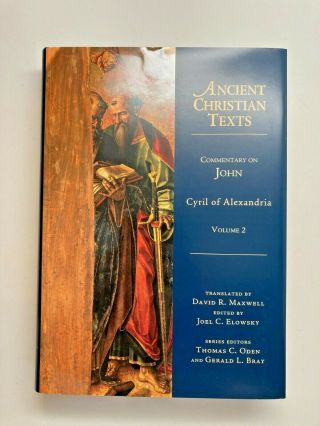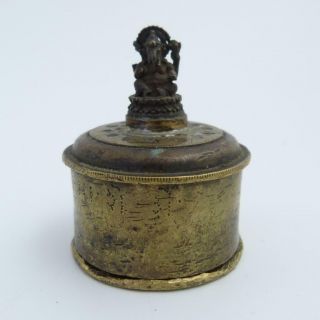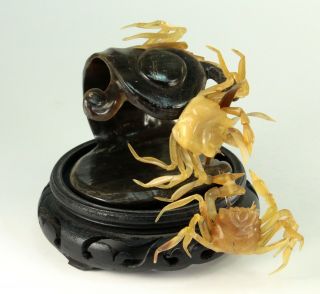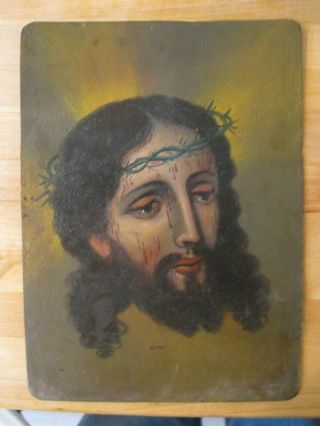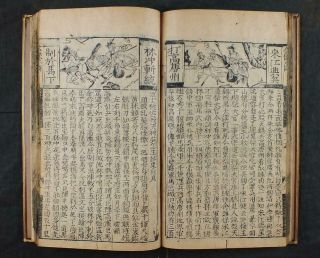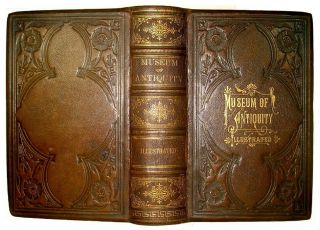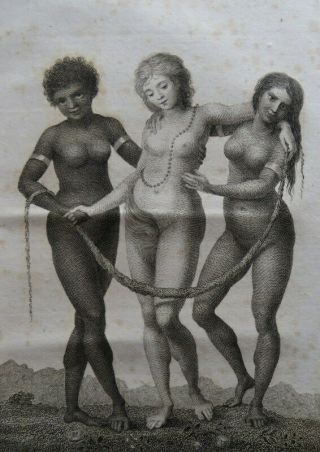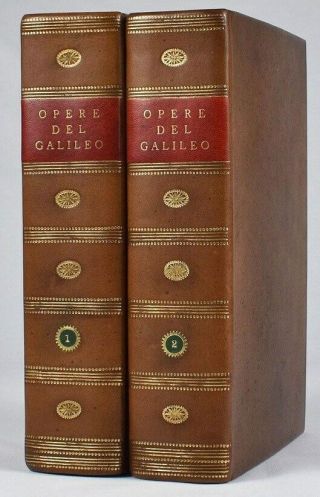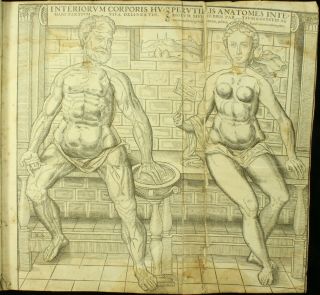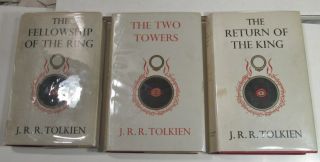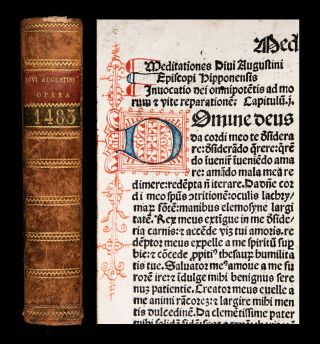1589 Heron Of Alexandria ON PNEUMATIC & HYDRAULIC MACHINES Physics Engineering
Item History & Price
[Physics - Fluid Mechanics] [Automata and Machines - Pneumatic and Hydraulic] [Early Illustrated Books - Scientific Illustrations - 16th century - Italy]
Printed in Ferrara by Vittorio Baldini, 1589.
FIRST ITALIAN EDITION. Two parts in one volume.
PROFUSELY ILLUSTRATED WITH 84 LARGE WOODCUTS, MOSTLY OF VARIOUS HYDRAULIC ...AND PNEUMATIC MACHINES!
Dedicated to Alfonso II d'Este (1533 - 1597), Duke of Ferrara.SCARCE 1ST EDITION OF THE 1ST ITALIAN TRANSLATION of the 'Pneumatics' by Heron (or Hero) of Alexandria (c. 10 AD - c. 70 AD), a Greek mathematician and engineer who worked in Alexandria, in Roman Egypt, and is considered the greatest experimenter of antiquity and a leading representative of the Hellenistic scientific tradition.His Pneumatica (Πνευματικά) describing machines working on air, steam or water pressure, written originally in Greek, was first printed in 1575 in Latin translation by Federico Commandino.
In this 1589 Italian version the translator, Giovanni Battista Aleotti, a notable Italian Renaissance architect and engineer, incorporated several ideas of his own.The book is richly illustrated with "eighty-four woodcuts, 42 x 50 mm to 142 x 102 mm, of which seventy-six are in the text of Hero and eight in Aleotti's appended text. The Hero woodcut illustrations follow manuscript models. These Ferrara blocks have more decorative elements than the set designed for the Urbino edition of the Federico Commandino's Latin translation (1575)." (Mortimer/Italian, 230)Among numerous ingenious machines and devices illustrated and described in the book perhaps the most remarkable are the aeolipile, a steam turbine device; the hydraulis, or water organ; a forge powered by a channel of water; a self-trimming oil lamp, etc. Also described are singing bird automata, various kinds of 'magic' goblets and vases, self-opening and closing doors, self-lighting fires and numerous other fascinating inventions.Pneumatics in Aleotti's Italian translation stirred great interest among Renaissance scholars. Focusing largely on spectacular effects achieved by means of hydraulics, the work proved of considerable interest for its use in theatrical machinery, and festival productions. The mechanical wonders of Heron's Pneumatica also provided a Renaissance Vitruvian architect and civil engineer with a useful source of ideas for (among other things) garden automata.The influence of Hero's works on the late 16th- and 17th-century European science was far-reaching indeed and can be found in the works of such scholars as Francis Bacon, Robert Boyle, Girolamo Cardano, Giambattista della Porta, Robert Fludd, and Athanasius Kircher."Hero's Pneumatica is essentially a treatise on natural magic, as later centuries called the study of the unexplained properties of nature, in which are described various mechanical contrivances worked by air water and steam. Most famous is the aelipile, a simple reaction turbine in which escaping jet of steam causes a pivoted ball to revolve. [...] The Pneumatica is of interest in the history of the scientific theory no less than in the history of technology, since its preface contains a discussion of air and vacuum which is of great interest. For Hero, air is a material substance, consisting of minute particles between which there is only vacuum [...] Further, air is compressible suffering expansion and contraction. Hero thus had a very satisfactory theory of elastic fluids, based on a particulate theory of matter. [...]"For a thorough knowledge of the properties of air Hero's Pneumatica was inevitable, being the standard textbook on the subject until, from the works of Torricelli, Pascal, Boyle and Mariotte, there emerged the modern theories of of the vacuum and of elastic fluids. [...] Even more important was his influence on the theories of matter. In contrast to the Aristotelian plenum, Hero's matter was particulate [...] By far the most important follower of Hero's atomism was Galileo [...] That Galileo read Hero we know; he owned a copy of the Italian translation [and] there is no reason to doubt that Galileo's atomic theory is closely related to that of Hero." (Marie Boas Hall, The Mechanical Philosophy, pp.545-554)"The 'Pneumatica' is a peculiar work, written in two volumes, which study, in 80 chapters, mechanical apparati, working with air, steam or hydraulic pressure. [...] Heron begins with a theoretical consideration of pressure in fluids. [...] There are, rather remarkably, descriptions of over 80 machines such as a fire engine, a wind organ, a coin-operated machine, and a steam-powered engine called an 'aeolipile', which has much in common with a jet engine. It is described as a hollow sphere mounted so that it could turn on a pair of hollow tubes that provided steam to the sphere from a cauldron. The steam escaped from the sphere from one or more bent tubes projecting from its equator, causing the sphere to revolve. The 'aeolipile' can be considered the first known device to transform steam into into rotary motion."[This 1589 Italian edition] published by Aleotti is the first edition in vernacular of the famous work of Heron. Aleotti utilised the translation from Greek to Latin made by Federico Commandino, [...] The translation of this work, due to its content, such as demonstrations that Heron gives of the use of water to play an organ or for the movement of stage machineries, will later provide fundamental basis for the design of the fantastic water games whereby Aleotti will grace the gardens which he designed, such as those designed for the Dukes of Ferrara in 1589, and to realize the scenographic machines that will make him respected and famous in his time as a scenographer. "Besides replacing the original title, Aleotti added a series of remarks, comments and additions that he titled 'Four Theorems not less beautiful & curious than others. And the way to artificially raise a duct of living or dead water, at the top of every tall tower'. The first three 'Theorems' describe the running of many machines that, inspired by the theory shown and by the examples given by Heron, in an increasingly complex manner allow the coordinated motion of automata which [effect] stage action with water jets and emission of sounds." (M. Cigola (ed.): Distinguished Figures in Descriptive Geometry and Its Applications, p.187-8)The first Italian translator of Heron's Pneumatica, Giovanni Battista Aleotti (1536 - 1646) was a Renaissance architect, engineer and scholar. He worked mostly in Ferrara under Alfonso II d'Este where he designed the façade of the University and helped design the facades of the Palazzi Bentivoglio and Bevilacqua-Costabili. He is also known for some designs done in Parma, including the Teatro Farnese and the hexagonal church of Santa Maria del Quartiere."Giovan Battista Aleotti pursued a long and intense professional activity, firstly at the court of the Este and then at the service of the Marquis Cornelio Bentivoglio […]. With the passage of the territories of Ferrara under Papal domination, in 1598 Aleotti was appointed to Architect of the Royal Apostolic Chamber, in 1600 Public Architect of the City and again in 1602 Architect of the Fortress of Ferrara. In these fields Aleotti applied his technical knowledge to such roles as engineer-architect, intellectual, writer, musician, and scientist at the same time pursuing the professional career of a scholar." (Cigola, op. cit., p.183)Aleotti designed "many secular and religious buildings in Ferrara, in the manner of Palladio. He showed more originality as a designer of theatre machines and stage sets, both for dramatic performances and public spectacles. In 1605-6 he constructed his first permanent "playhouse, in the old granary of Cesare d'Este, followed in 1610 by a temporary stage in the Castello Estense with a scaenae frons inspired by the Teatro Olimpico. […] Aleotti's masterpiece was the proscenium-arch theatre of the Pilotta in Parma, known as Teatro Farnese (constructed 1618–19)." (D. Kennedy (ed.): The Oxford Companion to Theatre and Performance, p.16).
Bibliographic references:Adams H-367. Hoffmann II, 358. Mortimer Italian 230. Riccardi I, 21, 1.Physical description:Quarto; text block measures 21.5 cm x 16 cm. Bound in 20th-century quarter-vellum over patterned paper-covered boards, with paper label to spine.Two parts in one volume (with continuous pagination).
Pagination: [12] 103, [1] pp. Signatures: ¶4 ✠2 A-N4.
Collated and COMPLETE.
Title-page with a superb architectural woodcut border incorporating various figures, grotesques and the arms of Alfonso d'Este, duke of Ferrara.Further illustrated with 84 fine woodcuts of hydraulic and pneumatic devices in text. Numerous woodcut decorative and historiated initials of various designs, some rather large; several woodcut head-and tail-pieces (grotesque and type-ornament), Note "Il fine..." at the end of both works set within woodcut cartouches.Aleotti's 'Quattro theoremi' has its own title-page with Baldini's Hercules device (leaf L4r); another woodcut Baldini's device - Daedalus - on the colophon page.Printed in roman and italic letter.Preliminaries include Aleotti's Dedicatory epistle to Alfonso d'Este; several prefatory poems and Tavola (table of contents).Colophon and register on verso of the final leaf (N4v) with a woodcut printer's device.Condition:Very Good antiquarian condition. Complete. Binding slightly rubbed, with some soiling. Internally, with occasional minor soiling, mostly marginal; Preliminary leaf par3 with light brownish stain (rather harmless). Light water-stain to bottom portion of a few leaves (mostly confined to the bottom margin). In all, a nice, genuine, wide-margined example of this fascinating richly illustrated work.
Please right-click on thumbnails below and choose "open image in a new window" option to see larger images.



